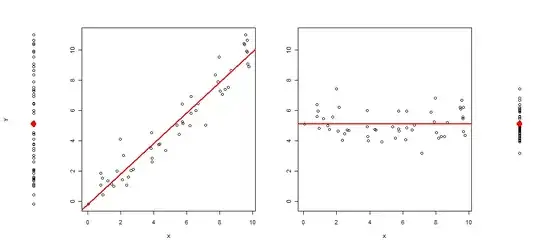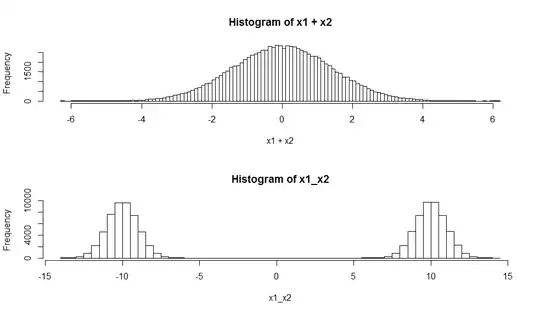I know that a sum of Gaussians is Gaussian. So, how is a mixture of Gaussians different?
I mean, a mixture of Gaussians is just a sum of Gaussians (where each Gaussian is multiplied by the respective mixing coefficient) right?
I know that a sum of Gaussians is Gaussian. So, how is a mixture of Gaussians different?
I mean, a mixture of Gaussians is just a sum of Gaussians (where each Gaussian is multiplied by the respective mixing coefficient) right?
A weighted sum of Gaussian random variables $X_1,\ldots,X_p$ $$\sum_{i=1}^p \beta_i X_i$$ is a Gaussian random variable: if $$(X_1,\ldots,X_p)\sim\text{N}_p(\mu,\Sigma)$$then $$\beta^\text{T}(X_1,\ldots,X_p)\sim\text{N}_1(\beta^\text{T}\mu,\beta^\text{T}\Sigma\beta)$$
A mixture of Gaussian densities has a density given as a weighted sum of Gaussian densities:$$f(\cdot;\theta)=\sum_{i=1}^p \omega_i \varphi(\cdot;\mu_i,\sigma_i)$$which is almost invariably not equal to a Gaussian density. See e.g. the blue estimated mixture density below (where the yellow band is a measure of variability of the estimated mixture):

[Source: Marin and Robert, Bayesian Core, 2007]
A random variable with this density, $X\sim f(\cdot;\theta)$ can be represented as $$X=\sum_{i=1}^p \mathbb{I}(Z=i) X_i = X_{Z}$$ where $X_i\sim\text{N}_p(\mu_i,\sigma_i)$ and $Z$ is Multinomial with $\mathbb{P}(Z=i)=\omega_i$:$$Z\sim\text{M}(1;\omega_1,\ldots,\omega_p)$$
And here is some R code to complement @Xi'an answer:
par(mfrow=c(2,1))
nsamples <- 100000
# Sum of two Gaussians
x1 <- rnorm(nsamples, mean=-10, sd=1)
x2 <- rnorm(nsamples, mean=10, sd=1)
hist(x1+x2, breaks=100)
# Mixture of two Gaussians
z <- runif(nsamples)<0.5 # assume mixture coefficients are (0.5,0.5)
x1_x2 <- rnorm(nsamples,mean=ifelse(z,-10,10),sd=1)
hist(x1_x2,breaks=100)

The distribution of the sum of independent random variables is the convolution their distributions. As you have noted, the convolution of two Gaussians happens to be Gaussian.
The distribution of a mixture model performs a weighted average of the RV's distributions. Samples from (finite) mixture models can be produced by flipping a coin (or rolling a die) to decide which distribution to draw from: Say I have two RVs $X,Y$ and I want to produce an RV $Z$ whose distribution is the average of $X$ and $Y$ If I flip a coin, let $Z=X$. if I land tails, let $Z=Y$.